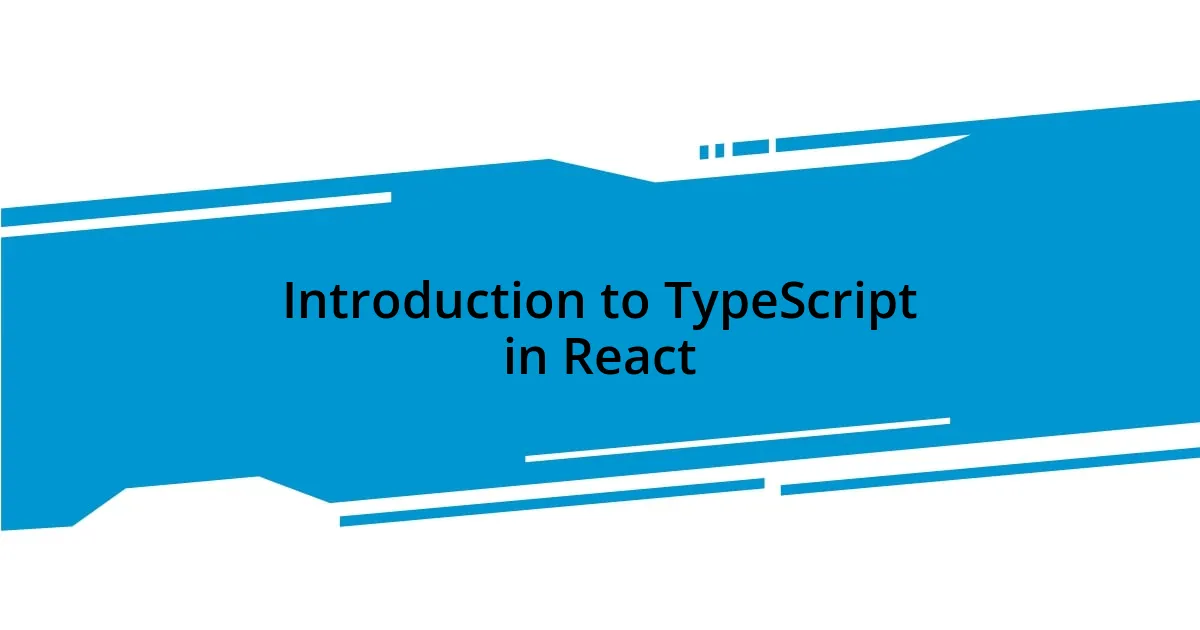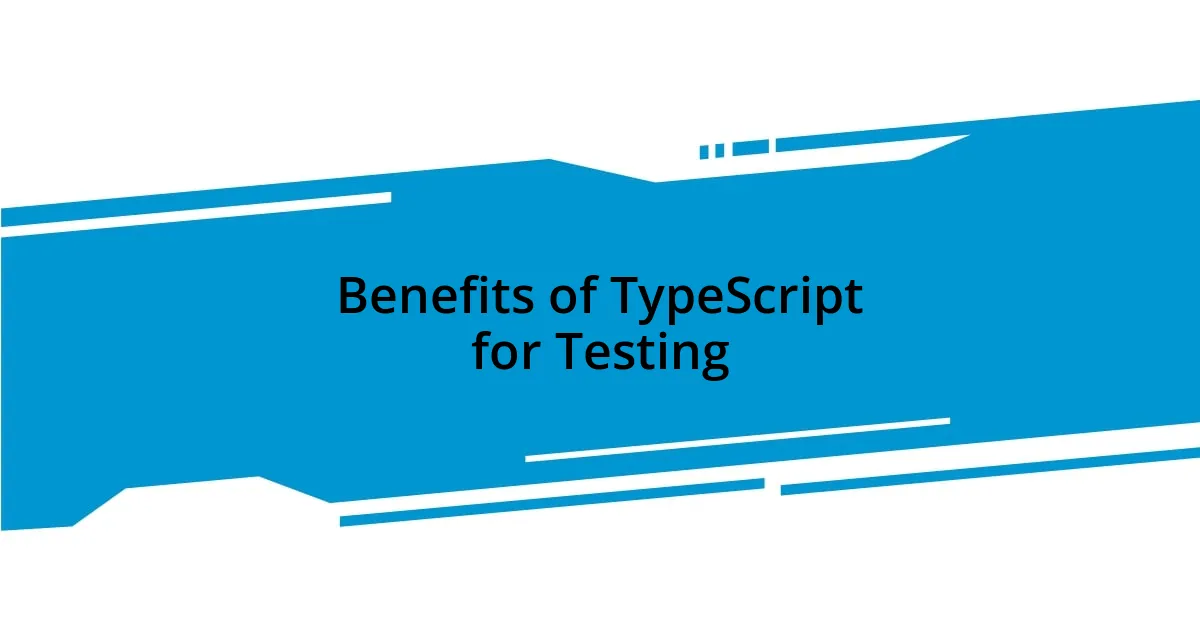Key takeaways:
- TypeScript enhances development by catching errors early, improving autocompletion, and facilitating clearer communication among team members.
- In testing, TypeScript’s strict type-checking minimizes runtime errors, enabling early error detection and easier test writing.
- Best practices include establishing clear type definitions and using descriptive naming conventions to enhance test readability and collaboration.
- Tools like Jest, React Testing Library, and ESLint are essential in streamlining TypeScript testing and maintaining code quality.

Introduction to TypeScript in React
Integrating TypeScript into React development has truly transformed my approach to building applications. Initially, I was hesitant, fearing that the additional type-checking would slow me down, but I quickly discovered that TypeScript helps catch errors early in the development process. Have you ever spent hours debugging only to find a simple typo? With TypeScript, those mistakes become much harder to overlook.
One of the most significant advantages I’ve experienced is the enhanced autocompletion and IntelliSense features in my code editor. For instance, when I’m defining component props, TypeScript provides instant feedback, allowing me to see what options are available. This not only boosts my productivity but also gives me a sense of confidence as I navigate through complex component structures, knowing I’m less likely to make silly mistakes.
I remember a particular project where we were collaborating with a large team, and TypeScript became our shared language. It facilitated clearer communication about prop types and component interfaces. Suddenly, I felt empowered to refactor components without the dread of breaking something. How often do you find yourself unsure about changes? With TypeScript, I found a new sense of clarity and assurance in my code, making the whole development experience that much more enjoyable.

Benefits of TypeScript for Testing
When it comes to testing, TypeScript really shines. The strict type-checking mechanism means that the potential for runtime errors is significantly reduced, which makes writing tests both easier and more predictable. I remember a time during a project where we were implementing a complex form with multiple input types. With TypeScript, I could rigorously define the shape of the data being submitted and immediately recognize discrepancies during testing. It felt like having a safety net; by preemptively catching potential issues, I saved valuable time and energy later.
Here are some notable benefits of using TypeScript for testing:
- Early Error Detection: TypeScript identifies type-related errors at compile time, allowing for faster debugging.
- Intelligent Autocompletion: Enhanced code assistance speeds up writing test cases, as I get immediate suggestions based on defined types.
- Improved Documentation: Types serve as in-code documentation, making it easier for team members to understand what each function or component expects.
- Refactoring Confidence: Knowing that I have strong type definitions allows for safe modifications and easier maintenance of test cases.
- Streamlined Collaboration: TypeScript’s clear definitions foster better communication within teams, ensuring everyone is on the same page regarding component usage.
Having experienced these benefits firsthand, I can genuinely say that TypeScript has elevated the quality and efficiency of my testing process, making it an essential part of my React development toolkit.

Writing Tests with TypeScript
When writing tests with TypeScript, I find that it truly refines the testing experience. The moment I start defining my test cases, I appreciate how TypeScript’s strict types help shape my thinking. For example, while testing a component’s behavior, I can be confident that I’m passing the correct props without having to double-check everything. This not only speeds up the process but also alleviates the anxiety of introducing bugs.
I’ve also noticed that using TypeScript makes my tests significantly more readable. When I write a test and a colleague glances over it, they can instantly grasp what inputs are expected just by looking at the type definitions. It reminds me of that feeling you get when you send a clear message to a friend and they understand it right away—it’s rewarding. The clarity in my tests fosters a collaborative environment, where discussions about what’s being tested become more constructive.
The enhancements TypeScript brings to test results are also worth mentioning. With the right type definitions, the feedback from my tests becomes crystal clear. I recall a time when a test failed due to a type mismatch, and I quickly pinpointed the issue without sifting through endless logs. The overall efficiency of catching these issues early is something I deeply value, and it empowers me to focus on writing high-quality code rather than getting lost in a sea of runtime errors.
| Aspect | TypeScript | JavaScript |
|---|---|---|
| Type-checking | Static, catches errors at compile time | Dynamic, may only catch errors at runtime |
| Autocompletion | Intelligent suggestions based on types | Basic suggestions |
| Documentation | Built-in type definitions act as documentation | Requires separate documentation efforts |
| Refactoring | Safe modifications with confidence | Risk of breaking changes |
| Collaboration | Clearer communication of expectations | Potential for misunderstandings |

Best Practices for TypeScript Testing
When it comes to best practices for TypeScript testing, I recommend establishing clear type definitions from the outset. I once jumped into a project without defining my props and found myself grappling with unexpected errors that took ages to resolve. By defining the shapes of my data early on, I streamlined my testing process, reducing both my time spent debugging and my stress levels. Isn’t it refreshing to step into a test with confidence, knowing exactly what data you’re working with?
Using descriptive and consistent naming conventions is another essential practice I’ve learned. For instance, when I named my test cases after the expected outcomes, it transformed my ability to navigate complex test suites. It was like reading a clear roadmap instead of flipping through a chaotic mess of papers. Good names create a narrative, helping both current and future collaborators quickly grasp what each test is scrutinizing. Wouldn’t you agree that clarity becomes your best friend in a testing environment?
Finally, I encourage using utility types effectively within TypeScript. There were times I leveraged types like Partial or Pick to focus my tests specifically on the properties I wanted to validate. This approach not only minimized unnecessary complexity, but it also enhanced my test readability. I vividly remember a moment when I realized I could make my testing concise and elegant. Isn’t it amazing how simplifying your approach can lead to greater clarity and impact?

Common Challenges in TypeScript Testing
One challenge I often face is the steep learning curve that TypeScript introduces, especially for those new to the language. I remember when I first dove into TypeScript, trying to understand all the fancy types and interfaces felt overwhelming. Have you ever experienced that moment of staring at a code snippet, wondering why nothing seems to work? It’s those moments that test your patience, but once you get past the initial confusion, everything starts to click into place.
Another hurdle I’ve encountered is dealing with third-party libraries that aren’t typed. There was a particular library I wanted to use in a project, and I found myself in a bind because the lack of type definitions meant I had to create my own. This can be both frustrating and time-consuming. Imagine wanting to enjoy a party but realizing you’re stuck outside trying to figure out the lock on the door. You begin to wonder: is it worth it? I’ve learned to balance the benefits against the effort, often opting for libraries that provide good type support.
Lastly, managing types across large codebases can quickly become a daunting task. I’ve often spent hours ensuring that my type definitions are consistent, especially when multiple developers are contributing. It’s like trying to keep a well-tuned orchestra where everyone plays different instruments. Do you ever feel overwhelmed by coordinating contributions? Maintaining harmony within the project is essential, and that means dedicating time to review and sometimes refactor types to keep things organized. This investment pays off, as it ultimately enhances the quality and reliability of the tests.

Tools to Enhance TypeScript Testing
One of the most valuable tools I’ve discovered for enhancing TypeScript testing in React is Jest. When I first started, I found Jest’s built-in support for TypeScript to be a game changer. It streamlined my test setup and allowed me to focus more on writing meaningful tests rather than getting lost in configuration minutiae. Have you ever felt the weight of manual setup pulling you down? I sure have, and with Jest, that burden was lifted more than I expected.
Another tool worth highlighting is Testing Library, particularly React Testing Library. It encourages writing tests that focus on user interactions rather than the implementation details, which I believe is crucial. I can’t tell you how much clearer my tests became when I shifted my mindset from testing components in isolation to simulating real user behaviors. Does that resonate with you? There’s something incredibly satisfying about seeing your project through the eyes of the end user, isn’t there?
Lastly, I find ESLint with TypeScript support invaluable in my workflow. It’s more than just a linchpin for maintaining code quality; it becomes a trusted partner, helping me catch potential type issues before they snowball into bigger headaches during testing. I vividly recall a scenario where ESLint flagged an inconsistency in my props that I had almost overlooked. It was one of those moments when I felt a wave of relief wash over me, knowing that such tools were watching my back. Don’t you appreciate having that extra layer of safety to catch those tricky little errors?
















